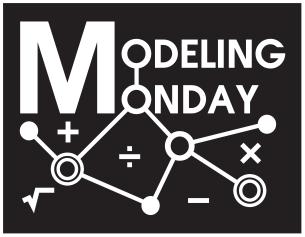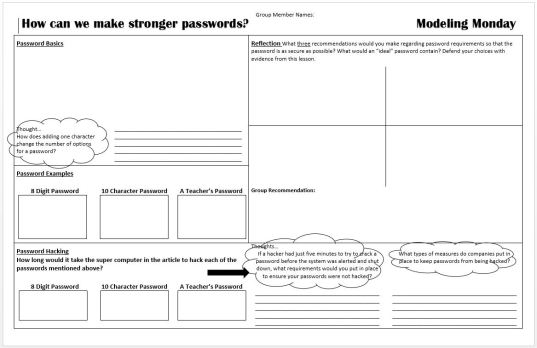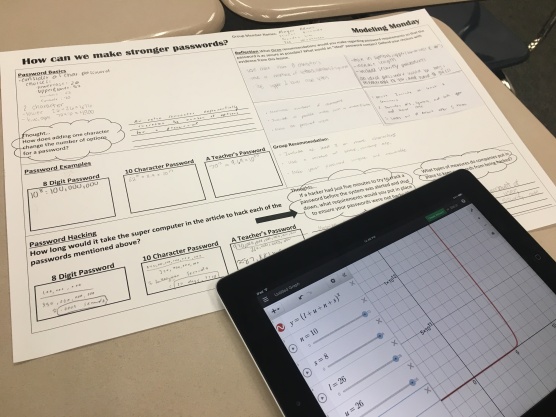
Our second Modeling Monday lesson for the 2016-2017 school year was both intriguing and applicable to our students. Remember that Modeling Monday was designed to give our 6th grade through 12th grade math classes an opportunity to do a lesson that wasn’t necessarily tied to a specific content standard. It has more to do with thinking and reasoning and experiencing, than securing knowledge on a particular topic. Our Math Team TOSA choose Robert Kaplinsky’s lesson on How Can We Make Stronger Passwords? lesson as the basis for our lesson this go around.
 We like to have something for the students to create so we made this poster for each of the groups to fill out. Most teachers, including myself, had the poster rotate between the group members to give everyone a chance to write. The lesson itself first went into the basics of simple passwords. This was especially important for the lower grades who had not experienced the idea of probability yet. After this, we explored how many possibilities a password could have if it was just 8 digits. Then we calculated the possibilities for a 10 character password using lowercase letters, uppercase letters and numbers (basically my Netflix password!). Finally we considered a 13 character password using the same options as before with having 8 symbols added to the mix of choices (this is the password I use for all my “teacher” stuff). After these calculation we looked at how “safe” they were based on an article that says a super cluster of computers can cycle though as many as 350 billion guesses per second. The students were amazed at how “unsafe” some of their own passwords really were!
We like to have something for the students to create so we made this poster for each of the groups to fill out. Most teachers, including myself, had the poster rotate between the group members to give everyone a chance to write. The lesson itself first went into the basics of simple passwords. This was especially important for the lower grades who had not experienced the idea of probability yet. After this, we explored how many possibilities a password could have if it was just 8 digits. Then we calculated the possibilities for a 10 character password using lowercase letters, uppercase letters and numbers (basically my Netflix password!). Finally we considered a 13 character password using the same options as before with having 8 symbols added to the mix of choices (this is the password I use for all my “teacher” stuff). After these calculation we looked at how “safe” they were based on an article that says a super cluster of computers can cycle though as many as 350 billion guesses per second. The students were amazed at how “unsafe” some of their own passwords really were!
The groups discussed what makes a “strong” password and what they would recommend as password requirements if they were setting the rules. Throughout the lesson we talked about the types of passwords we all have (phones, emails, debit cards, garages, online shopping sites, social media accounts, lockers, etc.) and why we even need passwords. I told them “back in my day” we didn’t really have passwords other than a locker combo.
Some levels went as far as to develop and equation that represented the number of possible passwords. We then graphed it with Desmos, and thanks to the sliders feature were able to see the impact that adding each type of character had on the overall total. Students came to the conclusion that if we just had a digit password, it takes a good 17 of them until the password gets “good” enough to not be hacked!
A colleague of mine had his students come up to his computer and enter in one of their passwords to this website How Secure is My Password. I happened to walk into his classroom when they were doing this. It was an eye-opener for many of his students!
I appreciated many things about this lesson! It was super applicable to my life and my students’ lives. It involved exponents, scientific notation, unit conversion, and probability to name a few topics. It had students working collaboratively at some points and independently in others. It used Desmos, which is always a plus. It was a good little Modeling Monday lesson and a nice way to return after our Thanksgiving break!

 The first part of the Modeling Monday lesson focused on graphical representations of data. This would include lots of discussion between students and would ask students questions they don’t normally get during a math lesson. The students were guided through a series of charts and maps all representing voting data from the 2012 Presidential Election. Each map had a new story to tell! Students were asked what they wondered about the chart breaking down the electoral college vote and the popular vote, how they could make the maps better, as well as make observations and look for patterns. They were asked how a certain map made them feel and if they preferred one map representation over another one. The discussions students had as they progressed from map to map were priceless. They were asked to think about the maps as a type of text to examine.
The first part of the Modeling Monday lesson focused on graphical representations of data. This would include lots of discussion between students and would ask students questions they don’t normally get during a math lesson. The students were guided through a series of charts and maps all representing voting data from the 2012 Presidential Election. Each map had a new story to tell! Students were asked what they wondered about the chart breaking down the electoral college vote and the popular vote, how they could make the maps better, as well as make observations and look for patterns. They were asked how a certain map made them feel and if they preferred one map representation over another one. The discussions students had as they progressed from map to map were priceless. They were asked to think about the maps as a type of text to examine. students to try their hand at district boundary drawing. After watching a short video explaining the concept of gerrymandering, students tried to create boundaries that satisfied a specific outcome. The students got really creative and clever about the district boundaries and were able to create so many viable options according to the constraints!
students to try their hand at district boundary drawing. After watching a short video explaining the concept of gerrymandering, students tried to create boundaries that satisfied a specific outcome. The students got really creative and clever about the district boundaries and were able to create so many viable options according to the constraints!